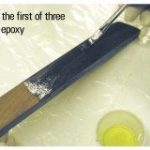Varnish Touch-ups & Take-downs

Those long lovely wooden toe-rails can be the bane of the warm weather sailor once it goes bad; but if you stay on top of the finish the pain is minimized, and you’ll have a real head-turner in the marina.
To keep brightwork healthy, approach it as you (hopefully) do your own health. Set a regular maintenance schedule (like an annual checkup), keep a first-aid kit on hand to address any symptoms of ill health, and practice preventative care (ignoring ailing varnish only makes the cure more grueling for the doctor).
Keeping varnished areas covered and rinsing them frequently with fresh water will mean less doctoring. Regular maintenance coats (before the coating begins to fail) will extend the life of a finish. Re-apply a teak oil or stain every three months or so; usually this just entails cleaning and re-coating the wood, although light sanding may be needed; follow maker suggestions. The timeframe for refreshing varnish alternatives will vary. Like varnishes, alternatives with a clear overcoat should be refreshed (two coats) annually; those without should be refreshed every six months or less in the tropics. If the gloss begins to look dull, it’s time for a refresher. A good scrubbing will remove dirt and grease, then sand the surface with 220- to 320-grit or bronze wool, and lay on two new finish coats.
Between refresher rounds with varnish, address scratches, lifting at joints, or blistered areas as quickly as possible to keep moisture from ruining the whole show. First, clean the spot with a recommended solvent, lightly sand with 100-grit (moving up to 320 – grit), feathering at the edges. After another pass with solvent and a tack rag, apply varnish and repeat until the thickness matches surrounding areas. This should be easier with the alternatives as their coating is softer and requires less sanding. To patch flaws in Cetol, clean the area, scrubbing against the wood grain, let it dry, and then apply the Cetol.
In a perfect world, the old coating easily lifts up. In the real world, an arsenal of scrapers gets the job done.
Having a varnish first-aid kit handy will make these “band-aids” easy and fast. A kit should include: a medium artist’s brush, handle cut to 1 inch; a cleaned spice jar; sheets of 100-, 220-, and 320-grit sandpaper; a tack rag; and a clean cloth rag. Screw the paint brush to the jar’s top with a self-tapping screw; fill the jar with varnish, and seal well. Rubberband the sandpaper to the jar, put the rags in a Ziploc, and stow it all in an easily accessible place. (Tips adapted from www.landlpardey.com.)
Whether it’s a varnish or a softer alternative, if it’s suffering from old age or widespread peeling, cracking, streaking, or simply lost its luster, a total overhaul is the only cure. Takedown methods for varnish include sanding (for removing thinner coatings), dry scraping or heating and scraping (best for thicker finishes), and chemical stripping. Heat guns and strippers should be used with caution around painted and fiberglass surfaces; rinse the stripper thoroughly from the wood as any residue will cause adhesion problems. For varnish alternatives: Sand with 80 grit and move up to 220, clean, and re-coat. Industry tests have shown that adhering to a tighter scale of increasing grit gets the job done quicker; an 80-120-150-200 step down is more productive than going directly from 100 to 220.
Our favorite resources on varnish maintenance include Don Casey’s “Sailboat Refinishing,” Rebecca Wittman’s “Brightwork,” and Sherri Board’s “Boat Cosmetics Made Simple.”




